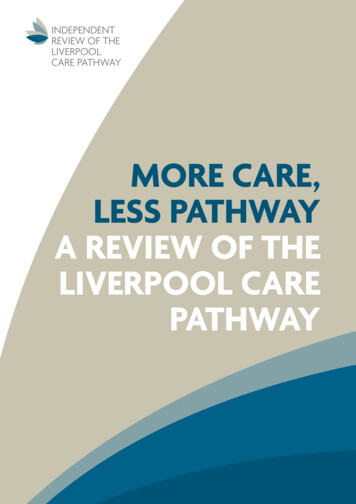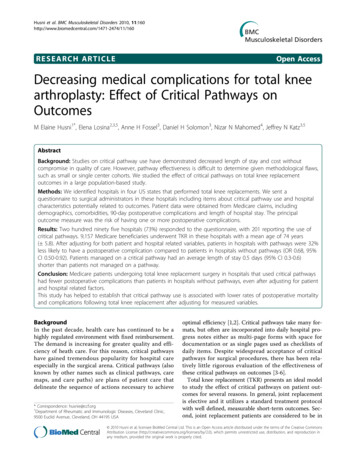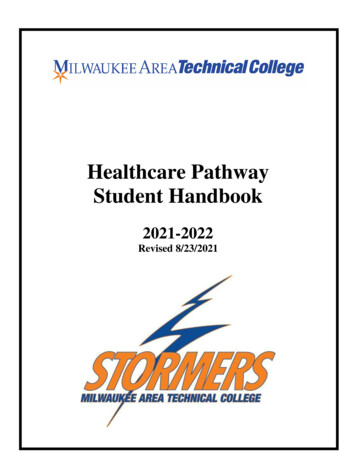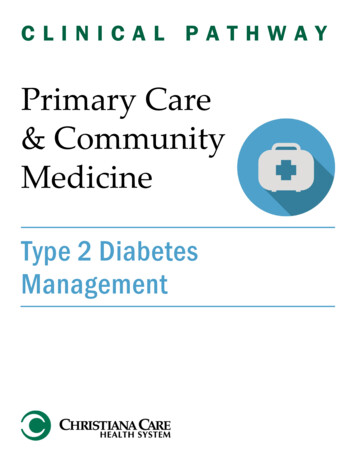
Transcription
INDEPENDENTREVIEW OF THELIVERPOOLCARE PATHWAYMORE CARE,LESS PATHWAYA REVIEW OF THELIVERPOOL CAREPATHWAY
ContentsCONTENTSForeword3Executive summary5The Liverpool Care PathwayUse and experience of the Liverpool Care PathwayEnd of life careThe place of the LCP in the dying processThe LCP – an integrated care pathwayEvidence base for the LCPLCP DocumentDiagnosis of dyingHydration and nutritionSedation and pain reliefAttempts at cardiopulmonary resuscitationUse of the LCP outside acute hospitalsGood care of the dying is not assisted dyingFinancial IncentivesWider issues raised by this reviewEnvironmentSupporting relatives and carers after the deathAccountabilityDocumenting an end of life care planCare of the elderlyAvailability of staff and 831323334353536363839404444Conclusion47Further information on the Review50Table of recommendations52Glossary601
REVIEW OF THE LIVERPOOL CARE PATHWAY REVIEW2
ForewordFOREWORDIn Britain, although most people would prefer to die in their own home, around half end their days inhospital. The proportion dying at home will increase, but because of a rise in the death rate, theactual numbers dying in hospital will also increase. The Liverpool Care Pathway for the Dying Patient(LCP) is an approach to care, including a complex set of interventions, that resulted from a desire toreplicate within the hospital sector the standard of care for the dying found in many hospices. It wasin part a response to the belief of clinicians and others that care for the dying in the acute sector wasdeficient.The introduction and widespread use of the LCP must be seen in the context of a number ofdevelopments in society itself. One of these is a substantial shift towards the idea of patient choice,with people increasingly likely to question treatment plans for themselves and their relatives, and toquestion the authority of clinicians. A second factor is that death and dying is now beginning to bedebated more openly.Nevertheless it seems still to be the case that, in practice, the discussion of death as an inevitableand, in some cases, imminent aspect of life is regarded as morbid and thus avoided. Even withpatients suffering from terminal conditions, it is common for there to have been no discussion withpatients, their consultants or GPs, relatives, and carers, about preparing for dying.Whatever decisions are made about the LCP (our recommendations are listed on page 52), we believethere needs to be a proper National Conversation about dying. Otherwise doctors and nurses arelikely to become the whipping-boys for an inadequate understanding of how we face our final days.We were asked to conduct this Review following alarming stories in the press and broadcast mediaconcerning the LCP. Some of these stories appeared to have much in common with the complaintsthat led to the Mid Staffordshire Public Inquiry, and with a spate of stories concerning the treatmentof the elderly in acute hospitals.Clinicians themselves expressed their own views that in their own last hours they would prefer to betreated under an approach such as the LCP, and we found that many relatives of people dying whilstbeing treated under the LCP had felt that their loved ones had had good deaths. It would seem thatwhen the LCP is operated by well trained, well-resourced and sensitive clinical teams, it works well.However it is clear to us, from written evidence we have received and what we have heard atrelatives’ and carers’ events, that there have been repeated instances of patients dying on the LCPbeing treated with less than the respect that they deserve. It seems likely that similar poor practicemay have taken place in the case of patients with no close relatives, carers or advocates to complain,or where families have not felt able or qualified to question what has taken place. This leads us tosuspect this is a familiar pattern, particularly, but not exclusively, in acute hospitals. Reports of poortreatment in acute hospitals at night and weekends – uncaring, rushed, and ignorant – abound.Where care is already poor, the LCP is sometimes used as a tick box exercise, and good care of thedying patient and their relatives or carers may be absent. Whether true or not, many familiessuspected that deaths had been hastened by the premature, or over-prescription of strong pain killingdrugs or sedatives, and reported that these had sometimes been administered without discussion orconsultation. There was a feeling that the drugs were being used as a “chemical cosh” which3
REVIEW OF THE LIVERPOOL CARE PATHWAY REVIEWdiminished the patient’s desire or ability to accept food or drink. The apparently unnecessarywithholding or prohibition of oral fluids seemed to cause the greatest concern.Preventable problems of communication between clinicians and carers accounted for a substantialpart of the unhappiness reported to us. Relatives and carers felt that they had been “railroaded” intoagreeing to put the patient on a one-way escalator.We feel strongly that if acute hospitals are to deal with dying patients – and they will – whether ornot they are using the LCP – they need to treat patients, their relatives and carers with more respect.Hospitals and other institutions need to make more time available to them at any hour of the day orany day of the week. We know that hospitals are often short staffed, and that senior staff may oftennot be present at night, over weekends, and on Bank Holidays. This is perceived by many as one majorcause of poor levels of care and communication. In order that everyone dying in the acute sector –can do so with dignity, the present situation has to change.It is for this reason that we make our strong recommendations for change.Baroness Julia Neuberger (chair)Lord Charles GuthrieDavid AaronovitchLord Khalid HameedTony BonserProfessor Lord Harries of PentregarthDenise Charlesworth-SmithProfessor Emily JacksonDr Dennis CoxSarah Waller4
Executive summaryEXECUTIVE SUMMARYDeveloped from a model of care successfully used in hospices, the Liverpool Care Pathway for theDying Patient (LCP) is a generic approach to care for the dying, intended to ensure that uniformlygood care is given to everyone thought to be dying within hours or within two or three days,whether they are in hospitals, nursing homes, or in their own homes.Because of substantial criticism of the LCP in the media and elsewhere, Norman Lamb MP, Ministerof State for Care Support, asked Baroness Julia Neuberger to chair a panel to review of the use andexperience of the LCP in England, to be kept independent of Government and the NHS. The Reviewconsidered evidence from many quarters: written submissions from members of the public andhealth professionals with experience of the LCP, as well as professional bodies and otherorganisations; a review of academic literature; a review of relevant hospital complaints; and surveysof health professionals. The panel also met members of the public at four sessions, to hear directlyfrom them their experiences of the LCP.TERMINOTo understand better how criticisms of the LCP were arising, the Review panel considered the LCPwithin its wider context. This gave rise to some underlying problems of definition and terminology.‘End of life’ can mean any period between the last year of life of a person with a chronic andprogressive disease to the last hours or days of life. Unless this lack of clarity is addressed, there isthe very real risk that a person deemed to be at the ‘end of their life’ may be placed onto the LCPtoo early.The term ‘pathway’ is clearly being misunderstood, being used to describe a very broad range ofinitiatives to provide care in the dying phase. It seems as though some doctors and nurses using theLCP are treating it as a set of instructions and prescriptions, which is not at all its aim. Furthermore, tothe lay person, a pathway suggests a road leading somewhere. Some relatives and carers have reachedthe conclusion that ‘the pathway’ represents a decision on the part of clinicians, in effect, to kill theirdying patients, when that is clearly not the case.The term ‘Liverpool Care Pathway’ is extremely unhelpful and should be abandoned. Within the fieldof end of life care, the term “pathway” should also be avoided, the simple term ‘end of life care plan’being the suggested alternative.EVIDENA rapid evidence review of integrated care ‘pathways’ for end of life showed there are specific gaps inevidence on the LCP, not least that independent, prospective testing of the LCP has not yet beencarried out after nearly 10 years of its dissemination. Fully independent assessments of end of life carein England are required, focusing on the outcomes and experience of care, as reported by patients,their relatives and carers, as well as the quality of dying. Further research into the biology andexperience of dying is needed.LCP doCumentationThe LCP document is designed to replace the contemporaneous medical records written by theclinical staff. But because it exists as a separate record on top of the continuation notes, it seems it is5
REVIEW OF THE LIVERPOOL CARE PATHWAY REVIEWeasy for staff (not least those who had had little or no training) to believe that both the LCPdocument and the continuation notes had to be completed, when they had not. The Review panelheard many reports of the form having been filled in wrongly, for example including observations thatthe relatives or carers believed had not been made. There may have been reasonable explanations forthis, but it provided resonances with the Mid Staffordshire Public Inquiry’s findings, and the Reviewpanel recommends that the professional regulators must take stern action with individual doctorsand nurses where there is evidence of the deliberate falsification of any document or clinical record,in order to deflect future criticism of a failure of care.DIAThere are no precise ways of telling accurately when a patient is in the last days of life, and the LCPdocument acknowledges this. Given the difficulty of diagnosing when a patient is actually going todie, placing patients on the LCP can lead to considerable distress in relatives or carers when thepatient does not die with hours or days, or recovers. Doctors and nurses must communicate withpatients and relatives far more honestly about these clinical uncertainties. More use of evidencebased prognostic tools and education and training in them is needed. More research is needed intoimproving the accuracy of these tools, where possible and where it is not, clear guidance and trainingis needed for doctors and MDTs on understanding and explaining the uncertain timings within thedying process.Approaches like the LCP have made a valuable contribution to improve the timeliness and quality ofclinical decisions in the care of dying patients, and plenty of evidence received by the Review showsthat, when the LCP is used properly, patients die a peaceful and dignified death. But implementationof the LCP is sometimes associated with poor care. Although this report highlights significantdifficulties with practice in care for the dying among some clinicians, those reading the conclusions ofthis Review should not respond, for fear of censure, by defaulting back to treating dying patients asthough they are always curable.DEThe Review panel heard many instances of both good and bad decision-making. Repeatedly, theyheard stories of relatives or carers visiting a patient, only to discover that without any forewarningthere had been a dramatic change in treatment. There now appeared to be no clinical care orpalliative care, and the patient was unnecessarily or excessively sedated. Every patient diagnosed asdying should have a clearly identified senior responsible clinician accountable for their care during any‘out of hours’ period. Unless it is unavoidable, urgent, and is clearly in the patient’s best interests, thedecision to withdraw or not to start a life-prolonging treatment should be taken in the cool light ofday by the senior responsible clinician in consultation with the healthcare team. The practice ofmaking such decisions in the middle of the night, at weekends or on Bank Holidays, by staff that donot have the requisite training and competence, should cease forthwith.ConsentOne of the central issues causing difficulty in the use of the LCP seems to be misunderstanding anduncertainty over whether deciding to implement the LCP is a treatment decision, requiring thepatient’s consent or requiring the decision to be taken in the patient’s best interests if they lackcapacity. In some cases, relatives and carers incorrectly consider they are entitled to decide whatever6
Executive summarytreatment their relatives receive, and in others clinicians fail to seek consent from a patient or consultthe relatives and carers in a ‘best interests’ assessment when treatment is being changed.The LCP is not a single, simple medical procedure, and so there is no legal requirement for consent tobe sought before it is used. Some aspects of the LCP do not concern treatment, but others, such asmedication changes, do. Patients, relatives and carers are always entitled to explanations of howdecisions have been made and a chance to understand them, but all too often they have not beenafforded that opportunity. The LCP documentation is deficient in making distinct and clear where theneed for consent and explanation exist.INVOContrary to the intentions of the LCP documentation, submissions to this review indicated that asignificant number of relatives and carers do not feel that they were involved in discussions about thecare plan, or even offered the chance to be involved. Some relatives and carers were handed a leafletwithout any explanation. Others were not told that their loved one was dying, which clearlycontributed to their distress. It appears that a conversation with relatives or carers to explain thediagnosis, prognosis and uncertainties clearly had simply not taken place. The GMC’s guidance isclearly not always being followed in the care of the dying, and so the Royal Colleges need to reviewthe effectiveness of training in shared decision-making that they provide to ensure competence ismaintained across the education and training spectrum.Hydration and nutritionMost of the submissions to the Review from relatives and carers that were critical of the LCP madereference to hydration and nutrition. Judging from these accounts, far too often the LCP advice onthese is not being followed. The current version of the LCP does not go far enough to adjust thelanguage of previous versions to advise that the default course of action should be that patients besupported with hydration and nutrition unless there is a strong reason not to do so.At the end of life, a person may become overhydrated, and there is no moral or legal obligation tocontinue to administer and clinically assisted hydration or nutrition if they are having no beneficialeffect. But there can be no clinical justification for denying a drink to a dying patient who wants one,unless doing so would cause them distress. In hospitals in particular, there appear to have been manyinstances demonstrating an inadequate understanding of the LCP’s direction on oral hydration.Refusing food and drink is a decision for the patient, not clinical staff, to make.The Review heard reports of patients being given drugs by a syringe driver so quickly that they rapidlybecame drowsy, and so unable to ask for something to drink. The offer of a drink was not discussed.The GMC has issued clear guidance on supporting artificial nutrition and hydration, but more isneeded on supporting oral nutrition and hydration. The NMC, from which no equivalent guidancecurrently exists, needs to produce it for nurses as a matter of urgency.SEDATIONThe Review heard that, if a patient became more agitated or in greater pain as they died, they oftenbecame peaceful because the right drugs were given to them at the right time and in the right dose.But there were complaints that opiate pain killers and tranquillisers were being used inappropriatelyas soon as the LCP was initiated. Many hospital patients appear to be put on a syringe driver withmorphine as the ‘next step’ on the LCP, even if morphine is not the right drug, or pain relief is not7
REVIEW OF THE LIVERPOOL CARE PATHWAY REVIEWwhat is needed. Some relatives and carers were unsure whether this meant that the death hadoccurred naturally or if it was directly attributable to the drugs administered. It seems that at leastsome of the distress experienced could have been mitigated by better communication. Before asyringe driver is commenced, this must be discussed as far as possible with the patient’s relatives orcarer, with the reasoning documented.ATTEMThe Review received evidence of conversations about attempts at cardiopulmonary resuscitationthat were held sensitively, patients and their families and carers having felt both consulted andinvolved in the decision making. However, it also heard of very vague, snatched conversations, inwhich relatives and carers felt pressurised to give an opinion, the implications which were not madeclear to them. Many people recounted that agreement not to attempt cardiopulmonary resuscitationhad been taken by the clinical staff as a proxy for agreement to start the LCP, which is clearlyunacceptable.ETSome people believe that to implement the LCP is a way of deliberately hastening someone’s death,and this is understandable, given what the Review heard about poor communication betweenclinicians and patients, their relatives and carers about what was happening during the dying process.The Review panel is content, however, that the LCP entirely reflects the ethical principles that shouldprovide the basis of good quality care in the last days and hours of a person’s life. Any attemptdeliberately to shorten a person’s life is illegal, but there is no obligation, moral or legal, to preservelife at all costs. The Review considered the issue of local financial incentives being applied per patienton the LCP, and concluded that this sort of incentive must cease in relation to any approach to careof the dying. Not only has it given rise to fears about hastening death for financial gain, but there is avery real risk that providing a payment for each patient implemented on the LCP, or equivalentapproach, looks like an incentive to do so, rather than a means of providing sufficient resources forgood quality and compassionate care to be provided.WIDERIn reviewing use and experience of the LCP, the Review identified a number of important issues thatimpact on the ability of the LCP and similar approaches to support high quality care of the dying. Ifthese wider issues are not addressed, no amount of changes to particular approaches to care of thedying will help.ENVIRONMENTThe review received little evidence on the facilities and environments provided for patients that weredying, and their relatives and carers. When it was mentioned by respondents, however, it was oftenthe case that rooms were not available where patients and families could talk privately or to meetand confer with staff. Similarly, facilities and support for those bereaved were not always available.APatients, their relatives and carers need to know who the senior responsible doctor in their care is.Dying patients must have a named consultant or GP taking overall responsibility for their care. If a8
Executive summarymedical practitioner is available, the responsible clinician role in the community could be held by anurse, as long as he or she has the right competencies.The responsible clinician is not only responsible for the care of the patient, but bears someresponsibility for their relatives and carers too. The name of a registered nurse responsible for leadingthe nursing care of the dying patient in a hospital should be allocated at the beginning of each shift,and this nurse should also be responsible for communicating effectively with relatives and carers.Organisations providing care for the dying, in particular acute hospitals, must ensure that the rightsystems are in place to ensure they deliver consistently good care, and so, as a matter of urgency, theboards of these providers should give responsibility to one of its members for leading on theinterests of the dying patient, their relatives and carers.Care witH ComPassionDuring this Review, the panel heard of far too many instances where the commencement of the LCPhas led to a withdrawal of care, in some cases with relatives and carers left to do the caringthemselves as much as they could. Caring with compassion for people at the end of their lives shouldbe the aim of all doctors, nurses and healthcare staff. Good care for the dying is as important asgood care at any other time of life.DOMany patients and their families felt as though they have lost control over what was happening tothem. Involving patients, their relatives or carers in discussions about the care plan is an importantway of restoring a sense of control. And good practice in documenting discussions and decisions isvital. Where a patient has no relatives or carers and so is unrepresented, the discussion about thecare plan needs instead to involve a GP from their registered practice or their senior responsiblecommunity clinician, who may be a nurse. The panel recommends a system of shared care folders inhospitals, to which relatives and carers can contribute, as well as better integration of documentationin the community.Care oF tHe eLderLyEvidence from relatives and carers strongly suggested that care of the dying elderly is of the greatestconcern: the Review panel suspects that age discrimination is occurring, which is unlawful. Nor shouldold age be taken as a proxy for lack of mental capacity. Each patient lacking capacity, of whatever age,on the LCP or a similar approach, should be represented by an independent advocate.AVAIThe availability of staff to care for the dying, both in terms of the number of staff and the level ofcompetence, is of serious concern. The Review panel repeatedly heard stories of poor standards ofbasic care and a lack of staff and equipment over weekends and out of hours; this also preventedsome people from being able to come home to die, as they wished. There were numerous reports ofno access to the palliative care teams outside office hours and at weekends, both in acute hospitalsand in the community. In some places there were separate teams for the community, the hospitaland in hospices. Such fragmentation must not continue and, wherever possible, palliative care teamsshould combine to form integrated palliative care services.9
REVIEW OF THE LIVERPOOL CARE PATHWAY REVIEWAbout half of all deaths currently take place in hospital, making care of the dying a core duty ofhospital trusts. Many of their patients would benefit from the skill and expertise offered by thepalliative care team. Lack of funding may be the reason that patients report a lack of access to thehospital palliative care team in the weekends and evenings. Funding must be made available to makepalliative care teams accessible at any time of the day or night, seven days a week, both in hospitalsand in community settings.CommuniCationsNo matter how much effort is put into training clinicians in good communication skills, unlesseveryone in society – members of the public, the press, clinicians, public figures – is prepared to talkopenly and honestly about dying, death and bereavement, accepting these as a normal part of life,the quality of care and the range of services for the dying, their relatives and carers will remaininconsistent. The Review panel strongly supports the work of organisations that promote publicawareness of dying, death and bereavement.Unless there has been good communication between staff and relatives or carers, unnecessarymisunderstandings and distress can arise. Care of the dying requires not only substantial technicalknowledge and clinical skill, but above all it needs excellent communication skills. Adequate trainingand continued support is the key to getting this aspect of care right.TRAININHealth Education England, the GMC, the NMC, the Royal Colleges and provider organisations shouldall play a part in improving the training and continuous professional development of cliniciansinvolved in caring for dying patients. Clinicians should be required to demonstrate proficiency incaring for the dying, doctors as part of each five-year cycle of revalidation; the principle of settingrequirements to demonstrate proficiency in caring for the dying should also apply to nurses. There isno specific NMC guidance for nurses caring for patients at end of life or who are dying, although suchguidance from the GMC exists for doctors. This may explain, at least in part, why the Review panelheard so many examples of poor quality nursing of the dying. The NMC must provide such guidanceas a matter of urgency.ANThe LCP is not being applied properly in many cases. Generic protocols, as the LCP has come to beseen, are the wrong approach. The Review panel strongly recommends the development of a seriesof guides and alerts reflecting the common principles of good palliative care, supplemented bytechnical guidance specific to certain disease groups. These guidelines must be so designed that theyare readily adapted for local use to meet the needs of individuals, in a similar way that examplesalready exist for the LCP.Use of the Liverpool Care Pathway should be replaced over the next six to 12 months by an end oflife care plan for each patient, backed up by condition-specific good practice guidance.ABut adherence to guidelines cannot be enough: a system-wide approach to professional practice andinstitution provision, measurable and monitored, is required to bring about improvements in care forthe dying. A strategic approach needs to be taken to the problem – a coalition of regulatory andprofessional bodies, NHS England and patient groups together setting clear expectations for a high10
Executive summarystandard of care for dying patients, as well as their relatives and carers. Such a coalition could lead theway in creating and delivering the knowledge base, the education training and skills and the long termcommitment needed to make high quality care for dying patients a reality.Under this approach, the CQC would collaborate with the professional bodies and patient groups indefining what good quality end of life care services should look like and then inspect against thosestandards. End of life care should be incorporated urgently into the new hospital inspectionprogramme that the Chief Inspector of Hospitals will run. The CQC should carry out a thematicreview of how dying patients are treated in all settings within the next year.NHS England must use its full powers to work with clinical commissioning groups to address what areconsiderable inconsistencies in the quality of care for the dying, to drive up quality by means ofconsiderably better commissioning practices than persist at present. Hospital provision in particularmust from now on be commissioned and prioritised according to local need, to ensure that properlyconstituted multidisciplinary specialist services are available for support around the clock as a hub ofexpertise, support and training.Unsurprisingly, this Review has uncovered issues strongly echoing those raised in the Mid StaffordshirePublic Inquiry: notable among the many similar themes arising were a lack of openness and candouramong clinical staff; a lack of compassion; a need for improved skills and competencies in caring forthe dying; and a need to put the patient, their relatives and carers first, treating them with dignity andrespect.In view of the Review panel’s serious concerns about the current state of care for the dying, itstrongly recommends that the Government set improved quality of care for the dying as a priorityfor NHS England in the next Mandate. Given the very strong links between the vulnerability of olderpeople and the quality of care for the dying, the forthcoming Vulnerable Older People’s Plan shouldinclude a strand on care for the dying, and NHS England’s contribution to it should also be specifiedas a priority in the NHS Mandate.Many of the problems in the care of the dying highlighted in this report are due to poorunderstanding among clinicians of existing guidance in care for the dying, and an unwillingness todiscuss with patients, their relatives and carers the prospect of death and the clinical uncertaintiesthat accompany it. The Government must therefore ensure that its arms-length bodies collaboratewith the clinical professional bodies and other key players in the system, and inject considerablefunding into the system, to ensure that guidance on care for the dying is properly understood andacted upon, and tick-box exercises are confined to the waste paper basket for ever.The Review panel feels so strongly about this that it is going to continue to meet at its own expenseand volition, to monitor closely what happens next in response to its recommendations.11
REVIEW OF THE LIVERPOOL CARE PATHWAY REVIEWCHaPter 1THE LIVERPOOL CAREPATHWAY1.1The trend over recent years has been for more deaths at home and fewer in hospital, but longterm projections1 indicate that institutional deaths will nevertheless increase by over 20%.1.2The Liverpool Care Pathway for the Dying Patient, commonly shortened to the LCP, wasoriginally developed by the Royal Liverpool University Hospital and the Marie Curie Hospice inLiverpool for the care of terminally ill cancer patients. The Marie Curie Palliative Care InstituteLiverpool (MCPCIL) has overseen the development and dissemination of the LCP since then,and the LCP now aims to ensure that uniformly good care is given to everyone, wherever theyare – in hos
Diagnosis of dying 19 Hydration and nutrition 26 Sedation and pain relief 28 Attempts at cardiopulmonary resuscitation 31 Use of the LCP outside acute hospitals 32 Good care of the dying is not assisted dying 33 Financial Incentives 34. Wider issues raised by this review 35. Environment 35 Supporting relatives and carers after the death 36











